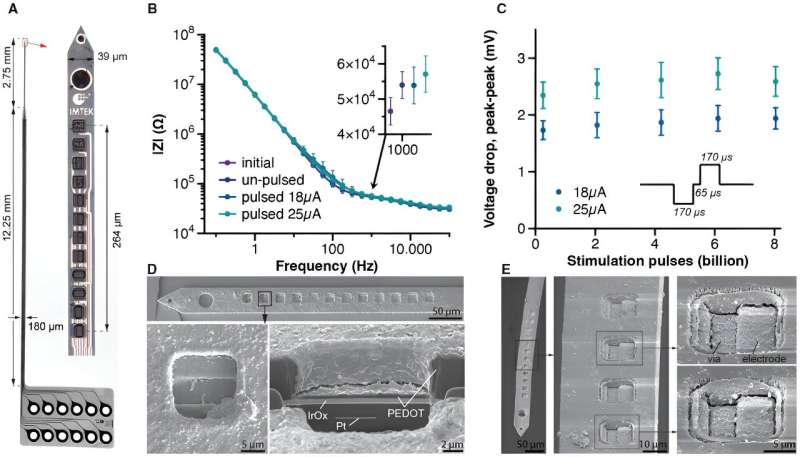This article has been reviewed according to Science X's editorial process and policies. Editors have highlighted the following attributes while ensuring the content's credibility:
fact-checked
peer-reviewed publication
trusted source
proofread
Researchers report exceptionally small implant for future vision correction

A group of researchers from Chalmers University of Technology in Sweden, University of Freiburg and the Netherlands Institute for Neuroscience have created an exceptionally small implant with electrodes the size of a single neuron that can remain intact in the body over time—a unique combination that holds promise for future vision implants for the blind.
The research, titled "Flexible Polymer Electrodes for Stable Prosthetic Visual Perception in Mice" is published in Advanced Healthcare Materials.
Often when a person is blind, some or part of the eye is damaged, but the visual cortex in the brain is still functioning and waiting for input. When considering brain stimulation for sight restoration, thousands of electrodes must go into an implant to build up enough information for an image. By sending electrical impulses via an implant to the visual cortex of the brain, an image can be created, and each electrode would represent one pixel.
"This image would not be the world as someone with full vision would be able to see it. The image created by electrical impulses would be like the matrix board on a highway, a dark space and some spots that would light up depending on the information you are given.
"The more electrodes that 'feed' into it, the better the image would be," says Maria Asplund, who led the technology development part of the project and is Professor of Bioelectronics at Chalmers University of Technology in Sweden.
The vision implant created in this study can be described as a "thread" with many electrodes placed in a row, one after the other. In the long term you would need several threads with thousands of electrodes connected to each one, and the results of this study are a key step toward such an implant.
The future of vision implants
An electrical implant to improve vision in people with blindness is not a new concept. However, the implant technology currently being explored in human patients is from the 1990s, and there are several factors that need to be improved, for example the bulky size, the scarring in the brain due to the large size, the materials corroding over time and the materials being too rigid.
By creating a really small electrode the size of a single neuron, researchers have the potential to fit lots of electrodes onto a single implant and build up a more detailed image for the user. The unique mix of flexible, non-corrosive materials make this a long-term solution for vision implants.
"Miniaturization of vision implant components is essential. Especially the electrodes, as they need to be small enough to be able to resolve stimulation to large numbers of spots in the 'brain visual areas.' The main research question for the team was, 'can we fit that many electrodes on an implant with the materials we have and make it small enough and also effective?' and the answer from this study was—yes," says Professor Asplund.
The smaller the size, the worse the corrosion
To create an electrical implant on such a small scale comes with its challenges, especially in a tough environment, such as the human body. The major obstacle is not to make the electrodes small, but to make such small electrodes last a long time in a moist, humid environment.
Corrosion of metals in surgical implants is a huge problem, and because the metal is the functional part, as well as the corroding part, the amount of metal is key. The electrical implant that Asplund and her team have created measures in at a miniscule 40 micrometers wide and 10 micrometers thick, like a split hair, with the metal parts being only a few hundred nanometers in thickness. And since there is so little metal in the super tiny vision electrode, it cannot "afford" to corrode at all, otherwise it would stop working.
In the past, this problem has not been possible to solve. But now, the research team have created a unique mix of materials layered up together that do not corrode. This includes a conducting polymer to transduce the electrical stimulation required for the implant to work, to electrical responses in the neurons. The polymer forms a protective layer on the metal and makes the electrode much more resilient to corrosion, essentially a protective layer of plastic covering the metal.
"The conducting polymer metal combination we have implemented is revolutionary for vision implants as it would mean they hopefully could remain functional for the entire implant lifetime. We now know it is possible to make electrodes as small as a neuron (nerve cell) and keep this electrode effectively working in the brain over very long timespans, which is promising since this has been missing until now.
"The next step will be to create an implant that can have connections for thousands of electrodes," says Asplund, something that is currently explored within a larger team in the ongoing EU project Neuraviper.
The method was implemented by the research collaborators at the Netherlands Institute for Neuroscience, where mice were trained to respond to an electrical impulse to the visual cortex of the brain.
The study showed that not only could the mice learn to react to the stimulation applied via the electrodes in just a few sessions, but the minimal current threshold for which mice reported a perception was lower than standard metal-based implants. The research team further reported that the functionality of the implant stayed stable over time, for one mouse even until the end of its natural lifespan.
More information: Corinne Orlemann et al, Flexible Polymer Electrodes for Stable Prosthetic Visual Perception in Mice, Advanced Healthcare Materials (2024). DOI: 10.1002/adhm.202304169





















